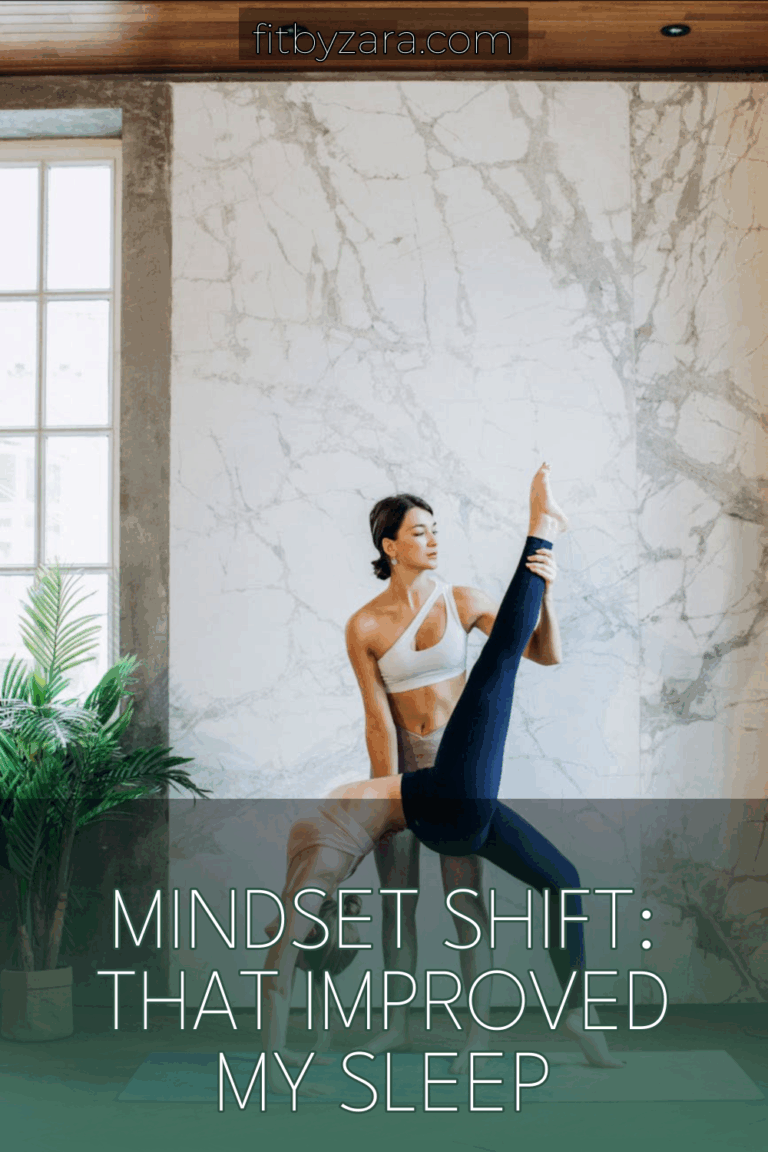Let’s be real: sleep is essential for our wellness, especially as we step into our 30s and beyond. It’s not just about hitting the pillow; it’s about how we approach our sleep. A simple mindset shift can make a world of difference in how well we rest at night. In this post, we’ll dive into practical strategies and insights that helped me transform my sleep routine. So grab your favorite herbal tea, get cozy, and let’s chat about sleep!

Hi, I’m Zara — fitness junkie, wellness nerd, and the voice behind FitByZara.com. This site is all about smart fitness and science-backed wellness tips for real women who want to feel their best.
Why Mindset Matters
3-Day Energy & Metabolism Reset
Grab the 3-Day Energy & Metabolism Reset — a quick-start guide to feel lighter, more energized, and back in control.

Where should I send your free reset guide?
When it comes to sleep, our mindset can be the game-changer. Here’s why:
- Expectations: The way we think about sleep can create anxiety. If we constantly focus on how we’re not sleeping well, we set ourselves up for a cycle of poor sleep.
- Routine: A positive mindset allows us to create effective routines that signal our bodies when it’s time to wind down.
- Awareness: Understanding your needs and limitations can help you approach sleep with a balanced perspective.
What Shifted for Me?
Before I made any changes, I had a pretty negative relationship with sleep. I thought of it as a time of stress—something I wasn’t good at. Here’s what I shifted:
1. From “I need to sleep” to “I’m giving myself permission to rest.”
– This subtle change helped me relax into sleep rather than stress about it.
2. From “I can’t sleep” to “I’m learning how to.”
– I began to view sleep as a skill that could be developed rather than a failing.
Key Strategies for a Better Sleep Mindset
1. Create a Sleep Sanctuary
Why it Matters: Your environment plays a big role in how well you sleep. A space that feels calming and restful can signal your mind and body that it’s time to unwind.
Checklist for Your Sleep Sanctuary:
- [ ] Dimmed Lighting: Use soft, warm lighting in the evening.
- [ ] Comfortable Bedding: Invest in quality pillows and sheets.
- [ ] Cool Temperature: Aim for a cooler room for optimal sleep.
- [ ] Declutter: Keep your sleep space tidy and free of distractions.
2. Establish a Wind-Down Routine
Why it Matters: Our bodies thrive on routine. A consistent wind-down ritual signals to your mind that it’s time to transition into sleep mode.
Wind-Down Routine Ideas:
- Gentle Yoga or Stretching: Helps release tension.
- Reading a Book: Opt for something light and enjoyable.
- Meditation or Deep Breathing: Focus on calming your thoughts.
- Journaling: Write down your thoughts to clear your mind.
3. Limit Screen Time
Why it Matters: The blue light from screens can interfere with our natural sleep-wake cycle. Reducing screen time before bed can help your body produce melatonin, the sleep hormone.
Mini Checklist to Limit Screen Time:
- [ ] Set a screen curfew (maybe an hour before bed).
- [ ] Use blue light filters on devices if you must use them.
- [ ] Replace screen time with relaxing activities.
4. Embrace Mindfulness
Why it Matters: Practicing mindfulness helps quiet the mind and reduce anxiety, making it easier to drift off to sleep.
Mindfulness Practices to Try:
- Guided Meditation: There are plenty of apps available.
- Breathwork: Focus on your breath to ground yourself.
- Gratitude Lists: Reflect on positive aspects of your day.
5. Shift Your Perspective on Sleep
Why it Matters: Change your relationship with sleep by reframing it positively. Instead of seeing it as a chore, think of it as an opportunity for self-care.
How to Shift Your Perspective:
- Focus on what sleep allows you to do: feel energized, be creative, and engage fully in life.
- Remind yourself that everyone has off nights and that’s okay.
Overcoming Common Sleep Obstacles
1. Anxiety About Sleep
Solution: Acknowledge your worries. Instead of trying to push them away, write them down before bed. This practice can help you let go of the day’s stresses.
2. Busy Mind
Solution: If your mind races, try a brain dump before bedtime—write down everything on your mind so you can relax without thoughts bouncing around.
3. Disrupted Sleep Schedule
Solution: Create a consistent sleep schedule. Go to bed and wake up at the same time every day, even on weekends. This regularity can help sync your body’s internal clock.
Zara Says
“Sleep is not a luxury—it’s an essential part of our wellness journey.”
Practical Tips for Different Sleep Styles
1. The Night Owl
- Challenge: Difficulty winding down at night.
- Tip: Gradually shift your bedtime earlier by 15-30 minutes each night until you find a comfortable schedule.
2. The Light Sleeper
- Challenge: Easily disturbed by noise or movement.
- Tip: Consider earplugs or a white noise machine to create a more stable sleep environment.
3. The Early Riser
- Challenge: Waking up too early and not feeling rested.
- Tip: Evaluate your evening routine—are you winding down too early? Adjust accordingly.
Conclusion
Improving your sleep is about more than just the hours you log in bed; it’s about cultivating a mindset that embraces rest and wellness. With these strategies, you can transform your relationship with sleep, making it a restorative and cherished part of your daily routine.
Remember, the journey to better sleep is personal, and it may take some time to find what works best for you. Be patient with yourself and enjoy the process!
Final Thoughts
Ready to embrace a new mindset around sleep? Remember, it’s all about creating a positive relationship with rest. You deserve it!
So, what will you try first? Let me know in the comments—your journey to better sleep starts now!
HepatoBurn: Gentle Support for Steadier Days
When you’re stacking real habits—protein-forward meals, steps, and 7–9 hours of sleep—HepatoBurn is a simple add-on that supports the system behind energy, appetite, and metabolic rhythm.
Why Women 30+ Use It
- Pairs with an already-solid routine—no jitters, no crash.
- Easy to remember: 2 capsules with meals.
- Plays well with protein, walking, and strength training.
How to Use
- Timing: Breakfast & lunch are easy wins.
- Consistency: Use daily for a fair assessment.
- Stacks: Protein-first plates, post-meal walks, lights-down wind-down.
What It Isn’t
- Not a stimulant and not a magic fix.
- Best used alongside habits you’ll actually keep.
- Educational only—talk to your provider before new supplements.
Important: Educational only, not medical advice. Supplements don’t diagnose, treat, cure, or prevent diseases. Talk to your provider before changes to diet, exercise, or supplements.






















